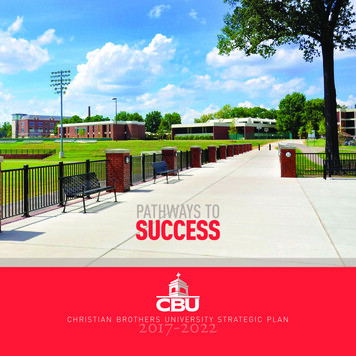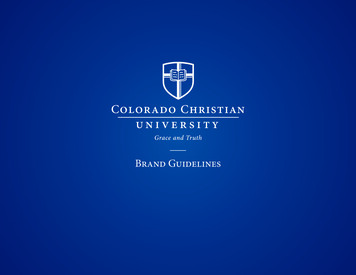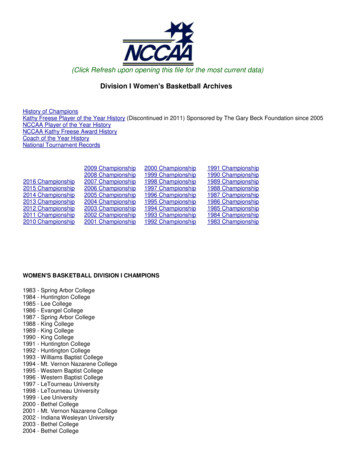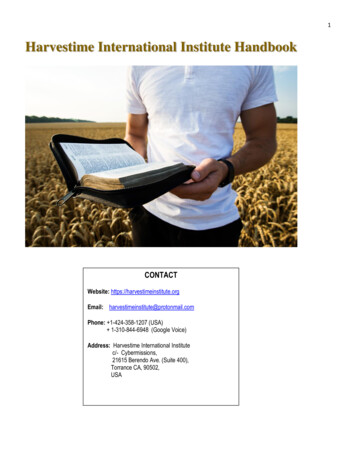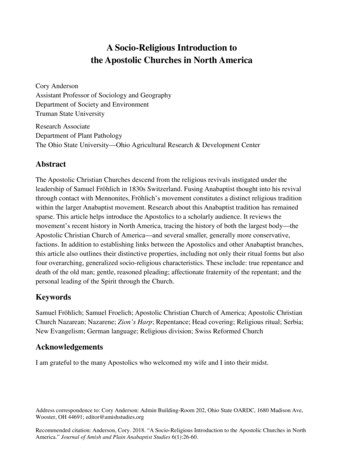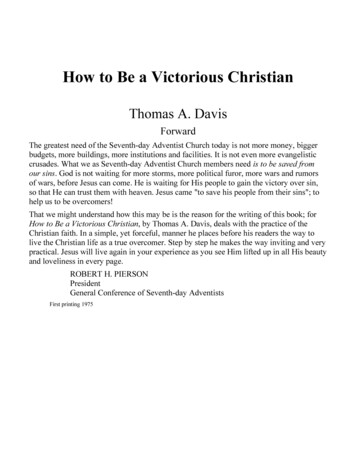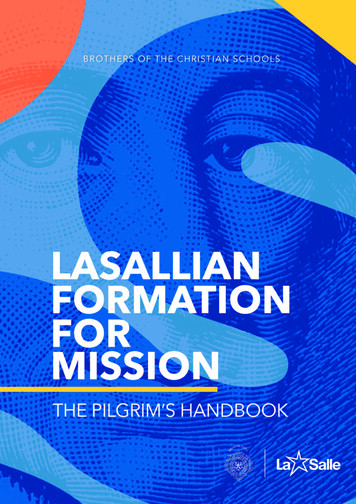
Transcription
THE BROTHERS OF THE CHRISTIAN SCHOOLSLASALLIANFORMATIONFOR MISSIONTHE PILGRIM’S HANDBOOKG E N E R A L AT E – R O M E2019
Lasallian Formation for MissionBrothers of the Christian SchoolsGeneralate - RomeFirst EditionEditorial TeamBr. Jesus Rubio Nazer, FSC - EditorBr. Paulo Dullius, FSCMr. Joseph GilsonBr. Felix Joseph, FSCMrs. Amanda ProulxBr. Robert Schaefer, FSCBr. Michael Valenzuela, FSCEditorial DirectionBr. Jorge Alexánder González Morales, FSCCommunications and Technology ServiceRomeDesignIngrid Jiménez Urbinacontacto@ingridjimenez.comNOVEMBER 2019
“.as I understand, congregations ofBrothers dedicated to teaching,like those of La Salle, have done a goodjob forming lay people with theirspirituality with good criteriaand wisdom.”“.the Lasallian Brothers havedone a good job forming their laityin charism, spirituality, and mission.”1– Pope FrancisPope Francis and Fernando Prado, CMF, The Strength of Vocation: Consecrated LifeToday. Publicaciones Claretianas, 2018. pp 47 & 951
Content
INTRODUCTION 7SECTION 01The Lived Experience of Persons as Starting Points111.2 The Primacy of the Lived Experience in the Formative Process14For Reflection161.1 The Personal Journey 121.3 The Context of the Person and the Community15SECTION 02The Cultural Context of Formation 192.1 Relationship between the Culture and the Person20For Reflection242.2 Lasallian Culture in Dialogue with Local Culture21SECTION 03What is Formation? 273.1 The Formative Journey 283.2 Proposing a Paradigm of Formation as a Lasallian PilgrimageFor Reflection3032SECTION 04Being Lasallians Today 354.1 De La Salle’s Formative Journey364.3 The Journey of One Becomes the Pilgrimage of Many394.2 The Thresholds of the Lasallian Formative PilgrimageFor Reflection3740SECTION 05Theological Foundations for Formation 435.1 Created in Love, in God’s Image and Likeness455.3 Freedom in the Image and Likeness of Jesus475.2 In the Image and Likeness of the Trinity5.4 Christ, the Spirit and FormationFor Reflection464849SECTION 06Building a Culture of Formation 536.1 Building an Inclusive Culture of Vocations556.3 Protection of Children and Vulnerable Adults576.2 Building a Culture of AccompanimentFor ReflectionSECCTION 075658The Lasallian Formation for Mission Matrix617.2 The 5 Five Domains: Enabling Lasallian Mission677.1 The Matrix7.3 The 5 Thresholds: Attending to People on The Formation Journey7.4 Threshold 1: Induction. . . from outside to inside636970
7.5 Threshold 2: Belonging from me to us727.6 Threshold 3: Commitment from career to calling747.8 Threshold 5: Wisdom. . . from positional power to charismatic witness787.7 Threshold 4: Co-responsibility from followers to leaders76SECTION 08Formation Programs 858.1 Responding to Needs 878.2 Developing Formation Programs 878.3 Goals 888.4 Participants 888.5 Personal Growth and Development 898.6 Methodologies 898.7 Content 908.8 Assessment 908.9 Resources 918.10 Logistics 91For Reflection 92SECTION 09Possible Formative Methodologies 959.1 Formation for Mission Experiences 979.2 Brother Formation Experiences 98For Reflection 99SECTION 10A Sample Program: Formation of Lasallian Formators for Mission10.1 Goals and Learning Outcomes10310510.2 Target Audience 10610.3 Program Content 10610.4 Formative Methodologies 108SECTION 11Tools for Formation Planning11111.1 At the Local Level 11311.2 At the District Level 11411.3 At the Regional Level 115A Sample Formation Planning Template 116SECTION 12Considerations for Brother Formation 12112.1 Formation Stages and Thresholds 12312.2 Academic Studies of the Brothers 12412.3 Safeguarding 12512.4 Formative Communities 126CONCLUSION 127GLOSSARY129
IntroductionLord, the Work is YoursConfronted by the human and spiritual distress of the children of artisans and the poor, John Baptist deLa Salle recognized in their situation a call from God. As he responded in faith, he came to see the work of theInstitute as a participation in God’s work of salvation. The Lasallian response is in this way a participation in thelarger movement of the coming of the reign of God, begun with the presence and ministry of Jesus and continuingto unfold in the ministry of the Church. This universal movement towards wholeness and wellbeing for all ofcreation is God’s mission, God’s Work.Lasallians continue to echo the words of the Founder: “Lord, the Work is Yours.” Today that educational effortin 80 countries around the world involves over one million students and educators.Lasallian Formation for Mission7
Lasallian Formation for MissionThe Lasallian mission is an expression of God’s loving concern, oriented particularly towards the wellbeingof the young and the poor, and lived out in association by an educational community. This community becomesa visible sign of the presence of God and gives expression to a variety of vocations in the Church. The modelof living religious Brotherhood created by John Baptist de La Salle and his first companions has inspired laypartners to understand and appreciate the Lasallian vocation lived out in diverse ways. These diverse vocationscomplement one another and bring a fullness and dynamism to the mission that it might otherwise lack.Lasallian formation for mission promotes the unity present in this diversity; it emphasizes what unitesBrothers and other Lasallians in the mission. Although some aspects of formation are particular to Brothersor to lay partners, many can be shared. Experiences of shared formation have proven beneficial for allparticipants. Therefore, an understanding of formation shared among the entire Lasallian Family is appropriateat this time in history.Following the mandate of the 45th General Chapter, which asked for an updating of the Brothers’ FormationGuide, the International Council of Lasallian Association and Educational Mission (CIAMEL) requested theGeneral Council to develop a single formation guide for all Lasallians while maintaining those formation elementsthat apply specifically to the Brothers. That decision led to the creative and innovative response that producedthis document.Primary Target AudienceThis present Handbook is the result of the reflection and writing of Lasallians – Brothers and Lay Partners– who have attempted to implement the global perspective of the Lasallian Family – all those who considerthemselves Lasallian and desire to grow in their understanding of this identity. Particular attention has beenfocused on those Brothers and other Lasallians who, either on their own initiative or because of their work, areengaged in forming and accompanying Lasallians throughout the world. In writing the handbook, the guidingquestion has been:What should formators and formation teams on the local, District and Regional level knowand be sensitive to regarding Lasallian formation for mission in order to plan, implementand evaluate formation experiences that will strengthen participation in the mission,charism and vocation for all Lasallians?The perspective of this Handbook is not merely the present, but also the future needs that are alreadybeginning to emerge. The best strategy for facing the various challenges of the future is formation, for which themost important challenge is developing an inclusive model that can reach everyone.General Intended OutcomesThe basic ideas of this text are already expressed in Chapter 6 of the Brothers’ Rule. The Rule’s insights andinspirations regarding the Brothers’ formation offer guidance and direction for the formation of all Lasallians.Therefore, this document seeks to: 8Provide an integrative approach to formation for Brothers and lay partners;Recognize the formative efforts that for many years, in varied cultural contexts, have been effective indeepening and sharing the Lasallian charism;Identify the essential elements of Lasallian formation and accompaniment for the entire Lasallian family;Develop for all Lasallians flexible guidelines to implement programs for lifelong formation that respond tocurrent and future needs.Lasallian Formation for Mission
Lasallian Formation as PilgrimageThis Handbook introduces the metaphor of formation as pilgrimage, understood as a personal and communaljourney of faith that deepens a sense of mission and purpose within individuals and a community. The pilgrimjourney of John Baptist de La Salle continues to inspire countless Lasallians today. A pilgrimage takes time;it involves pauses along the way that provide opportunities for insight and renew the pilgrim’s motivation tocontinue. A pilgrimage is not always easy or smooth and will include detours and interruptions. Those times arekey opportunities for growth.Previous formation documents have been instruction manuals and guides. These resources continue toprovide helpful reference for formators in the development of quality formation and should be consulted whenappropriate.This Handbook is intended to assist the formation process and to be an accompanying presence for formatorsalong the way. Ideally, it will re-frame Lasallian formation for mission for all and provide helpful tools andconsiderations for the ongoing renewal of formation programs and the vitality of the mission.Lasallian Formation for Mission9
01SECTION
The LivedExperienceof Personsas StartingPoints
1.1The PersonalJourneySince the time of the Founder, formation for mission has been understood as a practical response to prayerfulconsideration of real-life situations. Formators have tried to avoid abstract reflection which is not grounded in thelived experience of educational ministry. The sharing of formative experiences within a community of educatorsempowers and challenges each person to continue to grow in their understanding of themselves and of theirparticipation in the mission. This necessarily includes recalling the shared story and learning to participate in theshared spirituality, but formation goes much deeper: it enables all Lasallians to be protagonists in the ongoingstory of participation in God’s mission.12Lasallian Formation for Mission
“I was then invited to participate in formation As a wife and mother of three young children,these formation sessions were not always easy to manage but my husband agreed to help, andI began! Those two years were a revelation. Discovering the charism of John Baptist de La Salleand his journey allowed me to understand the mission of the Brothers of the Christian Schoolsbut especially to realize how, in my personal journey, God called me to be by their side to live thismission of human and Christian education. The flame was growing, a new breath. My job took onmeaning and became ministry, vocation.”“Accompanied by both Brother and lay mentors, I was introduced to the life and legacy of St. JohnBaptist De La Salle. As a beginning and grappling formator undergoing an intensive month-longformation, I was led to discover, understand, and accept my own brokenness and giftedness asa person. The communal life of studies, prayer, and fellowship made me appreciate who I am inthe context of community and inspired me to discover the gifts and potentials I bring to the newrole that was entrusted to me. Slowly, I was guided to understand that responding to the needs ofthe young is a way of my salvation. This purposeful and intentional journey of being formed andtransformed revealed to me the meaning of my encounters with every student, teacher, parent, andstaff in the school community. The God I call to became the God I live with in my day-to-day life.”“I have been enriched to a large extent by the witness, knowledge and presence of many people(Brothers and lay partners) who provide fundamental support in the mission and who have lefttheir ‘mark’ on me.”“In my formative journey, I became aware of the important place of poor children and young people.The formation team allowed our group to be close to the children and young people of the District, aprimary school and the high school directed by the Brothers. I have discovered the Lasallian charismmore and a deeper sense of my vocation. From this experience, I have integrated into my personal lifeproject young people in various situations of human, moral and spiritual distress.”“In my personal encounter with young people and adults in a diversity of settings, I’ve experiencedthe transformative power of the Lasallian charism and mission, which has profoundly shaped myCatholic faith, and my own vocation as husband and father. Beginning with that first encounterwith young people, the invitation, encouragement, and accompaniment I received on my journey isnow what I, and each of us, are called to offer one another and the young who we walk with to findtheir place in this world.”“Indeed, if I had ever thought that the care I was taking of the schoolmasters out of pure charitywould ever have made it my duty to live with them, I would have dropped the whole project. Itwas undoubtedly for this reason that God, who guides all things with wisdom and serenity, whoseway it is not to force the inclinations of persons, willed to commit me entirely to the developmentof the schools. God did this in an imperceptible way and over a long period of time, so that onecommitment led to another in a way that I did not foresee in the beginning.” (John Baptist de LaSalle, Memoir on the Beginning)Lasallian Formation for Mission13
1.2The Primacy ofthe Lived Experience inthe Formative ProcessAcross centuries and profound cultural shifts, the story of John Baptist de La Salle continues to be a sourceof inspiration for persons attracted to the Lasallian mission. As it was for De La Salle, it is, at first, a series ofimperceptible choices that eventually lead a person to more deliberate engagement. This frequently occurs throughone of three main entry points: Faith, Service, and Community. Some are attracted to the richness and relevance ofLasallian spirituality; others to educational service with the poor; and still others appreciate the joy and dispositionof a welcoming community. There is no order or hierarchy among these three pillars of Lasallian Identity. Overtime, an interest in any of them tends to draw in the other two to provide a sense of unity, belonging, identity andgrowth. This happens as a result of integrating one’s personal experience through quality formation.From the charismatic founding event that gave birth to the Lasallian story, dialogue between personal andcommunal experiences has always been the starting point for the formation pilgrimage. Lasallian identity andspirituality find their origins in the practice of reflecting on daily experiences to recognize God’s loving presenceand action. This dynamic interaction “touches the hearts” of Lasallians and moves them to become co-workerswith God in the mission. Lasallian formation is always an experience of a shared journey, of mutual learning andgrowth. Formation is thus a lifelong option of deepening the awareness of a shared vocation.Lasallian identity and spirituality find theirorigins in the practice of reflecting ondaily experiences to recognize God’sloving presence and action.14Lasallian Formation for Mission
1.3The Contextof the Personand the CommunityBecause a Lasallian community is ‘the context, the recipient, and the agent’ of formation, it can be referredto as a formative community. The community supports and challenges each of its members toward growthand integration. A Lasallian formative community acknowledges the unique experience of each person. Thecommunity therefore adapts to the members’ diverse generations and lifestyles and modifies expectations andgoals accordingly.The witness of an authentic community oriented toward mission is one of the gifts the Lasallian globalfamily offers to the Church and to the world. The great blessing of pluriformity inherent in the Lasallian missionis reflected in formation which adapts to meet local and regional contexts. Effective formation calls for flexibilityand adaptability rather than for a monolithic approach.The process of planning quality Lasallian formation recognizes the opportunities and challenges of the localcontexts and structures.Examples of the diversity that exists throughout the Lasallian community include: Geopolitical and linguistic boundaries within Districts and RegionsCompeting educational systems and bureaucratic requirementsCanonical and civil relationships regarding ownership and management of institutionsAvailability of financial, human and other resources for formationSustainability of the missionSecularization, cultural diversity and religious plurality.The unique personal context of each Lasallian must always be respected and acknowledged in the formationprocess. In the coming-together of Lasallians to form educational communities, the significance of shared contextand culture becomes obvious and operational.The process of planning quality Lasallianformation recognizes the opportunitiesand challenges of the local contexts andstructures.Lasallian Formation for Mission15
FOR REFLECTIONRecall your formation journey to this point. Can you identify a formationexperience that strongly impacted your growth in Lasallian identity? Whatelements and experiences contributed to its efficacy?Similarly, can you identify a formation experience that fostered a positiveand effective outcome for you? What elements or experiences were missingor misplaced?What are the greatest challenges to effective formation in your particularcontext?
02SECTION
The CulturalContext ofFormation
2.1Relationship betweenthe Culture andthe PersonFormation considers the culture wherein the person and the community find themselves. Culture can bestbe understood as the complex set of specific spiritual, material, intellectual, and affective traits that characterize asociety or social group. Culture includes not only arts and letters, but also ways of life, fundamental human rights,value systems, traditions, and beliefs. Understanding culture helps a formator to better understand persons andtheir network of significant relationships, especially regarding schools and communities. Lasallian formation formission necessarily prioritizes the circumstances and needs of children and youth, particularly those who are poorand marginalized.20Lasallian Formation for Mission
2.2Lasallian Culturein Dialogue withLocal CultureThe inclusive character of the global Lasallian community is a source of strength and blessing for everymember. In many parts of the world, the Lasallian community is a powerful witness to the potential of authenticdialogue among people from different belief traditions. Contemporary Catholic teaching emphasizes the priorityof engaging all people of good will in building authentic community, practicing good works and sharing indialogue. The Catholic identity of the Lasallian mission drives the community to seek the common good in holisticeducational service to young people. Lasallian formation, therefore, welcomes everyone who is interested in andcommitted to this mission. Formation experiences are enriched through the contributions of the diverse religiousexperiences and creeds represented within a community. Authentic formation acknowledges differences whilebuilding bridges for cooperation and fraternity.Practically speaking, a Lasallian formator acknowledges the local context as well as the historical developmentof the mission and of formation planning, and offers best-practice suggestions for each context within those areas,without attempting to be exhaustive.Within this context, the formator (See pages 22-23):Remembers that for Young Lasallians:Exposure to and appreciation for theBrothers and their role in the futureof the Lasallian Family is important.Lasallian Formation for Mission21
TRADITIONALCATHOLIC /CHRISTIANCATHOLICISM INTRANSITIONINTER- / MULTIRELIGIOUSTakesadvantageof assumedfamiliaritywith andappreciationof Catholiclanguage andsymbolsExplains andoffers aids foruse of key terms/symbols, e.g.Order of Mass,verbal reminders(symbols as a wayto affirm identity)Utilizes languagesand texts of othertraditionsAcknowledgesexplicitlythe Church’sbrokennesswhereappropriatePromotes harmonyand dialogue as keyconceptsEmphasizesconnection tonature/creationMakes use ofunifying andIntegrativeLanguageUses aninvitational toneIntroduces other’ssymbols and ritualsUtilizes silenceand meditationRecognizes thatschool oftenfunctions as theprimary faithcommunityFosters sharedexperiences whichstrengthen thesense of communityRelies on everydaysymbols whichevoke a feltresponse (connectvia the affect)LANGUAGE &SYMBOLSMotivatestowardsmature andconsciousdecisionfor adultdiscipleshipPRAYER& FAITHFORMATIONEXPERIENCESExtends explicitwelcome andinvitation, withoutexpectation ofshared belief orpracticeMakes frequentuse of synonymsto build points ofconnectionUtilizes silence andmeditationEmphasizes pointsof encounter in(shared) languageand beliefSECULARIZEDINTERGENERATIONALRelies onprofessional andsocial sciencelanguage tointroduceconcepts such as:· Lasallian· Spiritual /Humanist· Christian· Catholic· VocationalRelies on a variety ofapproaches requiredto meet the range ofsensibilities likely to bepresentCreates a varietyof experiencesthroughout courseof program asappropriateIntroducessymbols oneby one, withexplanation(proportionality)Draws onLasallianspirituality as anopportunity towelcome allThe Catholic identity of the Lasallianmission drives the community to seek thecommon good in holistic educationalservice to young people.22Lasallian Formation for Mission
BECOMINGLASALLIANSBEYONDBORDERSInvitesLasalliansto broadentheir sense ofwho can beLasallian inother contextsIncreasesappreciationfor the CatholicChristiangrounding ofLasallian mission,association, andSpiritualityBuilds capacityto explain andappropriate theCatholic Christianelements ofLasallian heritage(e.g. parables, goodshepherd, guardianangels, Christ,Christ’s role in theworld)Buildsappreciationfor Lasallianeducation,leading towardsappreciationfor CatholicEducation,towardsappreciation ofbroader Catholic/ Church role insocietyIncreasesknowledge of thebreadth of worksin the InstituteShares toolsfor explicitand effectiveevangelizationand catechesisFORMATIONCONTENTNEEDS ANDGOALSFosters anunderstandingof the schoolas pastoralministryOffers a refresheron basic tenetsof (Catholic)ChristianityUtilizes bestpractices inculturallysensitivedialogue,especially forthose engagedin explicitevangelizationand catechesisIncludes anintroduction toworld religionsIntroduces Inter- /Multi- Religiousdialogue andcultural sensitivityDevelops capacityfor meaningfulcommunicationacross differenceAssists Lasalliansto deepen theircommitmentto mission andassociationRemembers thatfor older Lasallians:The mission is viabledespite the changingrole/witness/numbersof BrothersRemembers that forYoung Lasallians:Exposure to andappreciation for theBrothers and theirrole in the future ofthe Lasallian Family isimportantBuilds capacity forintergenerationalcommunication andunderstandingFeatures thepromotion of thecommon goodKeeps aneye towardsfostering comfortwith Lasallianspirituality(invitational)Although complex, culturally-aware and sensitive formation planning is not an impossible task. Ideally, theabove table will assist in the ongoing development of high-quality, experience-driven formation by encouragingreflection and discussion regarding the particular cultural context in which formation occurs.Remembers that for older Lasallians: Themission is viable despite the changingrole/witness/numbers of Brothers.Lasallian Formation for Mission23
FOR REFLECTIONHow would you locate your Lasallian community within the various culturalcontexts described in the table? Why?How can you attempt to ensure openness to and appreciation of thisdiversity as you develop, implement and evaluate formation programs?
03SECTION
What isFormation?
3.1The FormativeJourneyEveryone, in their unique personal histories and contexts, is engaged in a life-long, formative journey.One’s experiences and encounters help to give meaning to life and ministry and facilitate one’s ongoing humandevelopment. These formative experiences and encounters unfold dynamically, in response to each person’sinternal and external realities. Self-knowledge and personal acceptance are increasingly significant elements in aformative journey.Although each person’s journey is unique, shared human experience has shown that certain archetypaljourneys are common to many people. These shared journeys can be understood as pilgrimages, which areproposed by cultures and societies. Each pilgrim undertakes a personal journey while also joining others on a28Lasallian Formation for Mission
similar path toward a common destination. Giving a pilgrimage lasting significance are those vantage points alongthe route that invite the pilgrim to stop, contemplate, and be transformed by what is seen and experienced. Thesepauses are opportunities for integration and growth: threshold experiences that precede the next steps.In reflecting on the formative journey of John Baptist de La Salle, one can observe a step-by-step path ofconstant growth in faith and understanding. De La Salle’s pilgrimage led him from “one commitment to another”through the calls and responses he made in day-to-day experiences and in decisive, threshold moments. In hisprayerful reflection on his life, De La Salle perceived this rhythm and responded positively to these invitations.Formation is the process of reflecting on experiences which invite and challenge one to continue the journeytoward integral human development.The Spirit of Faith allows one to see this formative journey as a dialogue with God. Sensitivity to the ongoingexperiences of one’s pilgrim journey contributes to understanding the current human context and to recognizingthe action of the Spirit in the world and in people. De La Salle was aware of and sensitive to the needs of his time,particularly those of poor and working-class children and their families. Today, all Lasallians must cultivate thatsame awareness. God continues to be visible through love and justice, goodness and mercy, so we must strive toembody love, to practice justice, to work for peace, and to guarantee the integrity of creation. Formation allowsthis transformative process to begin, assists in its unfolding and offers an orientation towards its destination.Formation is the process of reflecting onexperiences which invite and challengeone to continue the journey towardintegral human development.Lasallian Formation for Mission29
3.2Proposing a Paradigmof Formation as aLasallian PilgrimageWith John Baptist de La Salle as a model, an archetypal Lasallian pilgrimage is available to all who wishto engage in formation. Lasallian formation for mission has developed over centuries as a result of the ongoingreflection of all Lasallians on their personal and communal experiences. “Formation ‘touches the heart’ of eachperson. At different times in their formative journey, each person is challenged to integrate the various contentsand processes of formation. The process of personal integration is ongoing and leads to transformation and change.”(MEL 51, 3.4) These opportunities for integration are the common vantage points along the Lasallian pilgrimage.A strong sense of community and association gives the Lasallian pilgrimage its distinctive character andidentity. As a result, some individual Lasallians come to recognize a call to assist and accompany their fellowpilgrims through the service of formation. Accompaniment implies walking with others on the journey, sharingwisdom and insights learned from the Lasallian pilgrimage. Formators also develop and propose experienceswhich invite persons to encounter threshold moments throughout the pilgrimage.From the lived experience and wisdom of formation in many contexts and over many years, a commonLasallian frame of reference has emerged. It is clearly articulated in MEL Bulletin 51, section 5, in the form of 10Principles upon which Lasallian formation for the mission is based:1.2.3.4.5.6.7.8.9.10.Formation is for mission.Formation is transformative.Formation promotes association for mission.Formation responds to local and global needs.Formation starts with the individual.Formation is integrative.Formation takes place in community.Formation develops a particular spirituality.Formation presents the founding charismatic event as a source of inspiration and discernment.Formation is lifelong.Accompaniment implies walkingwith others on the journey, sharingwisdom and insights learnedfrom the Lasallian pilgrimage.30Lasallian Formation for Mission
These key principles articulate an integrated approach to the activity of the mission, the experience ofassociation, and the process of formation in community. Integrating mission and association through formationassists Lasallians to know and live their vocation. The words of De La Salle, “It is a good rule of life to make nodistinction at all between the work of our vocation in life and the work of our salvation and perfection,” become akey guidepost for all Lasallian pilgrims.Mission, association and formation are manifestations of the same movement of the Spirit. They are alwaysdiscerned by individual Lasallians within the community and then directed outwards towards a world in need ofthis charismatic gift of educational service.Integrating mission and associationthrough formation assists Lasallians toknow and live their vocation.Lasallian Formation for Mission31
FOR REFLECTIONWhat aspects of your formative journey have assisted you in integratingmission and association with your personal development and growth?What insights emerge when you
Previous formation documents have been instruction manuals and guides. These resources continue to provide helpful reference for formators in the development of quality formation and should be consulted when appropriate. This Handbook is intended to assist the formation process and to



